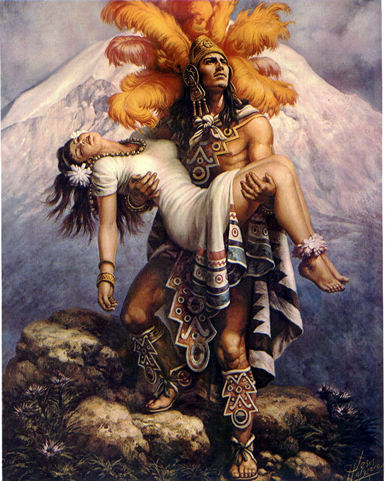|
|
|
La Malinche |
Popular images of Cortes and La Malinche
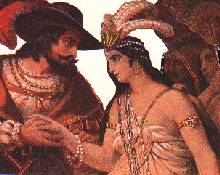 |
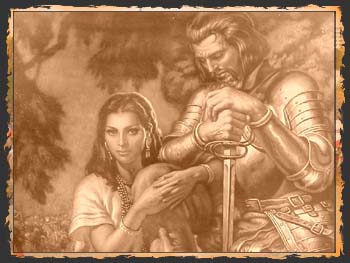 |
Popular Art & Drama depicting La Malinche
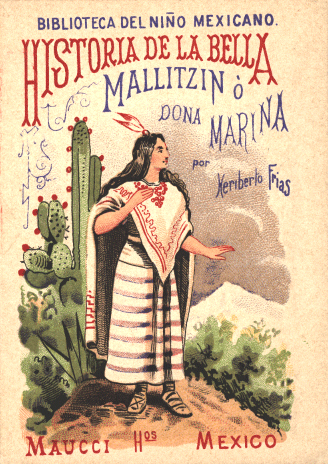 |
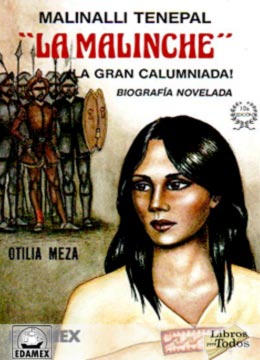 |
An Indian who was a captive of the Aztec empire, the woman who came to be known as "La Malinche," "Malintzin," or "Dona Marina" was acquired by the Spanish conquistador Hernan Cortes (1485-1547) as an interpreter during the Conquest of Mexico.
She became Cortes's lover and bore his son but they later separated, which led to her occasional folk identification with La Llorona as an Indian woman abandoned by a Spanish lover.
Anglos may romanticize La Malinche on account of her mediating position between two cultures, whereby she fits some anthropological and feminist theories on women's roles.
Renaissance depiction of La Malinche standing between
Spaniards (left) and Indians (right),
positively as interpreter or mediator,
negatively as woman caught between two worlds and potential traitor to either
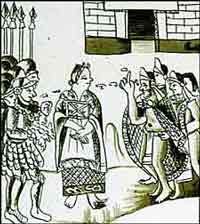
Mexicans & Mexican Americans know La Malinche better and have a more mixed or negative attitude--more likely to view as traitor, prostitute, sell-out, because just as North Americans romanticize North American Indians, Central and South Americans may romanticize the Indians before contact with Europeans.
![]()
TzvetanTodorov.
The Conquest of America: The Question of
the Other.
Translated from the
French by Richard Howard.
NY:
Harper & Row, 1984. (Editions du Seuil, 1982).
100 The second essential figure in this conquest of information is a woman, whom the Indians call Malintzin and the Spaniards Dona Marina, without our knowing which of these two names is a distortion of the other; the form most frequently given is La Malinche. She is offered as a gift to the Spaniards during one of the first encounters. Her mother tongue is Nahuatl, the language of the Aztecs; but she has been sold as a slave to the Mayas, and speaks their language as well.
Hence there is a rather long chain of interpreters at first: Cortes speaks to Aguilar, who translates what he says to La Malinche, who in her turn speaks to the Aztec interlocutor. Her gift for languages is obvious, and she soon learns Spanish, which further increases her usefulness. We can imagine that she retains a certain rancor toward her own people, or toward some of their representatives; in any case she resolutely chooses to side with the conquistadors.
In fact, she is not
content merely to translate; it is evident that she also adopts the Spaniards'
values and contributes as best she can to the achievement of their goals.
On the one hand, she performs a sort of cultural conversion, interpreting
for Cortes not only the Indians' words but also their actions; on the other
hand, she can take the initiative when necessary, and addresses appropriate
words to Montezuma (notably in the episode of his arrest) without Cortes's
having spoken them previously.
101
Revealing, too, is the nickname
the Aztecs give to Cortes: they call him Malinche (for once, it is not the woman
who takes the man's name).
The Mexicans, since their independence, have generally despised La Malinche as an incarnation of the betrayal of indigenous values, of servile submission to European culture and power. It is true that the conquest of Mexico would have been impossible without her (or someone else playing the same role), so that she is responsible for what occurred.
I myself see her in quite a different light--as the first example, and thereby the symbol, of the cross-breeding of cultures; she thereby heralds the modern state of Mexico and beyond that, the present state of us all, since if we are not invariably bilingual, we are inevitably bi- or tri-cultural La Malinche glorifies mixture to the detriment of purity--Aztec or Spanish--and the role of the intermediary.
![]()
Popular Mexican American art romanticizing Indians before European contact
